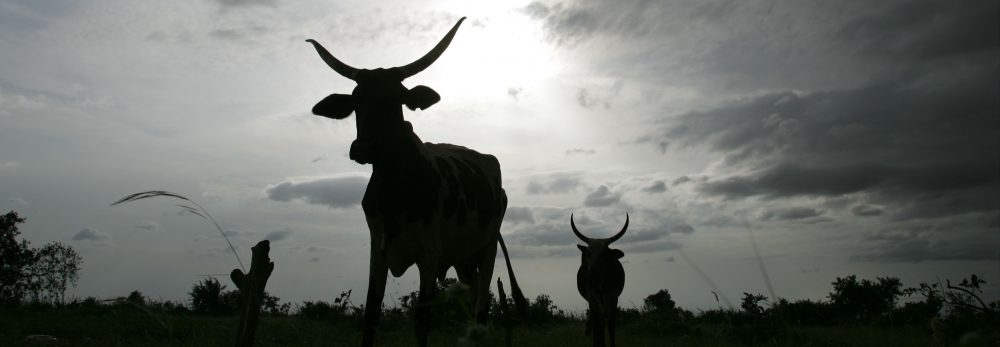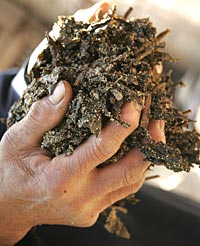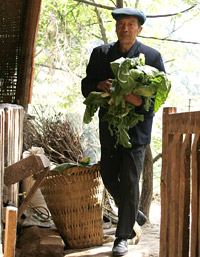Kenya's new Dairy Development Policy aims to bring Kenya's estimated 39,000 informal milk traders into the formal sector.
BBC World Service began to broadcast a Kenya dairy story on 6 April 2006, the same day Kenya’s Minister for Livestock and Fisheries Development, Joseph Munyao, presented a new Dairy Development Policy in Nairobi – the final step before the new Policy and accompanying Dairy Development Bill are presented to Kenya’s Parliament.
Kenya’s new Dairy Policy now broadly reflects the approach the International Livestock Research Institute (ILRI) and its partners have advocated over the past several years – the need to engage with and develop the country’s hugely important informal milk market, which provides a livelihood to an estimated 1.8 million smallholder households.
The new Dairy Policy now clearly acknowledges the role of the informal market actors in the development of the sector. The policy states that it will ‘facilitate the transformation of the informal milk trade towards formalisation’. Specific measures mentioned include development of low-cost and appropriate technologies for small investors, training programmes on safe milk handling, efforts to improve the standards of milk processing in the informal sector, provision of incentives for improved milk handling, and establishment of a supportive milk dealer certification system. The Dairy Policy also announces that the Kenya Dairy Board functions will be streamlined and steps will be taken so that the Board regulates itself and is managed by its stakeholders.
The new Dairy Policy is a huge step forward in a struggle that has been ongoing since 1998, when Kenya’s big milk buyer (Kenya Co-operative Creameries) went into liquidation. Various attempts were subsequently made to oust smallholders from the market, including media campaigns advising that unpasteurized (‘raw’) milk was unsafe and should not be consumed. The BBC Kenya Dairy Story, broadcast on its World Service, tells how the smallholders, supported by ILRI and partners, fought back, and how they are now being brought into the formal milk market. The Kenya Dairy Story was broadcast from 6-13 April 2006.
|
Small is Beautiful – The Kenya Dairy Story
Kenyans love their milk. Most of the 4 billion litres consumed there each year is produced by smallholders with a couple of cows, and sold house-to-house by thousands of street hawkers and doorstep milkmen. But this whole milk business was under threat. In the third edition of the One Planet series (on BBC World Service) which is sharing small business success, Susie Emmett discovers how the farmers and traders fought back to keep the milk flowing.
 Listen to a recording of the BBC World Service broadcast produced by WRENmedia. Listen to a recording of the BBC World Service broadcast produced by WRENmedia.
|
Note: The latest numbers
Some of the numbers quoted in this BBC World Service broadcast ‘Small is beautiful’ have been obtained from much earlier estimates. These figures, however, grossly understate the true size and extent of Kenya’s milk sector. SDP has provided recalculated figures, which more accurately reflect the picture in Kenya today.
1. Smallholder dairy farms recalculates to be 1.8 million (up from 800,000)
The estimated 800,000 smallholder farms has been widely cited for many years, during which time Kenya’s population has grown significantly. SDP recalculates the number of smallholders to be 1.8 million.
2. Milk hawkers recalculated to be 39,650 (up from 30,000)
SDP recalculates the number of small milk vendors in Kenya to be 39,650.
3. Number of dairy cattle recalculated to be 6.7 million (up from 3 million)
There are concerns about the reliability of the official cattle figures for Kenya; no livestock census has been conducted for decades and the methods used to estimate cattle numbers are imprecise. A conservative estimate of the size of the national dairy herd using detailed SDP survey data suggests that there are about 6.7 million dairy cattle (2.7 million high grade and 4 million crosses) owned by 1.8 million rural smallholder farms mainly in the Kenyan Highlands. This projected cattle population is more than twice the officially reported figure of 3 million for the national herds.
4. Total milk produced recalculated to be 4 billion litres per annum (up from 3 billion)
Based on SDP’s recalculated cattle projections above, SDP recalculates total milk production in the rural highlands to be an estimated 4 billion litres per annum.
5. Annual consumption of milk recalculated to be 145 litres per person (up from 100 litres)
SDP recalculates annual milk consumption by Kenyans to be 145 litres per person, making Kenyans amongst the highest milk consumers in the developing world. The rural areas have an estimated population of about 14.5 million people. Assuming that the estimated 9.6 million people living in the urban areas mainly depend on milk from the high potential areas, and that 13 percent of production goes to calf feed or spoilage loss, milk availability from the highlands was estimated to be about 145 litres per person per year. Previously, milk consumption in Central and Rift Valley provinces, which are important milk production areas, has been estimated to be between 144 and 152 litres per person per year.
Source: SDP Policy Brief No.10.
Highlights from the Kenya Dairy Story broadcast by BBC World Service:
In Kenya, a knock on the door means the milkman is here – today as everyday – delivering fresh raw milk to one of his many grateful customers. “I like this milk because this one comes daily, and it is fresh and good, that’s why I like it” says one of his customers.
This milk vendor serves approximately 60 customers, and sells approximately 100 litres of raw milk, each and every day. In Kenya, more than 30,000 milk hawkers [recalculated in August 2006 to be 39,650] are out daily on their bicycles or pushing carts to deliver nutritious milk from 800,000 small dairy farms [recalculated in August 2006 to have risen to 1.8 million].
Despite all its success, this whole wonderful milk business was under threat. The government here, as in so many countries, decided that small-scale farmers and traders couldn’t supply milk as safely as large farms and dairies. So, how come the hawkers are still in business, as are the smallholder dairy farmers whose milk they sell?
Kenya has three million improved dairy cattle [recalculated in August 2006 to have risen to 6.7 million] – that’s the largest dairy herd in Africa – and most of them are on small farms. Almost half the three billion litres of milk they produce are sold direct from small farms to households nearby. So the question is, can smallholder farmers produce clean, safe milk? Research by ILRI and others says yes – and changed lives because of it.
But what about that other all-important business criteria: efficiency; are the smallholder dairy farmers here in Kenya efficient? Steve Staal, agricultural economist at ILRI, says research shows smallholder dairy farmers are actually very competitive. ‘Indeed, small-scale mixed crop-and-livestock production is likely to be a more sustainable way to intensify agricultural production in environmental terms than large-scale industrial livestock production’, says Staal.
The biggest threat to smallholders came a few years ago when the one big buyer in Kenya – The Kenya Cooperative Creameries – went bust. Government policies did not recognize the small-scale operators and thus they were deemed to be operating illegally. Amos Omore is part of the team at ILRI trying to boost dairy incomes for the poor. He remembers how big dairy business was not going to let Kenya’s 800,000 [1.8 million] new milk entrepreneurs get in their way. It was a clash between big and small.
Kenya’s official ban on milk hawking was based on the milk not being safe. The nation’s newspapers carried many such stories. In the face of this scare-mongering, researchers got researching. David Mwangi at the Kenya Agricultural Research Institute (KARI), says that the public health risks being talked about were minimal – ‘almost not there’.On average, Kenyans drink 100 litres of milk a year, [recalculated in August 2006 to be 144–152 litres of milk a year] making them among the highest milk consumers in the developing world. But they don’t drink milk as it comes. ILRI’s Omore says the research showed that most consumers boil fresh milk before drinking it, which makes it as safe as pasteurized milk.
Gathering this evidence was a huge step. Using that evidence to change policy and mindsets was another.
KARI’s Mwangi says, ‘We worked with advocacy groups and hosted a high-profile meeting. And we had facts to table there.’ This research helped lead to the Kenya Dairy Board approving training for smallholder milk producers and traders. That’s important: most members of smallholder dairy cooperatives depend on their milk money to educate their children. Furthermore, easing restrictions against small traders helps poor customers because of the price of processed milk is beyond the means of most poor people here.’
John Kutwa, a former ILRI technician in the dairy team, says that ‘small’ characterizes most of Kenya’s milk business. ‘It’s small farmers selling to small traders and processors who deliver to small (poor) consumers.’
ILRI’s Amos Omore has been battling on behalf of smallholder milk producers and sellers since their troubles began. And he’s battling still. ‘Right now the policy environment has shifted towards small-scale traders’ he says. But the change is not yet complete. Small businesses are important but often overlooked.
‘Changing policies takes time’, he says, ‘and so does changing attitudes. In this country in the 1960s and 70s, it was always assumed that development projects should be “mega” to achieve some quantum leap in development. But if you look at development holistically – in terms of employment, in terms of nutrition, in terms of cash flow – these are the stepping stones that allow people to move from one living standard to the next. Small is beautiful! Small should not be sacrificed at the altar of large-scale businesses that often fail.’







































